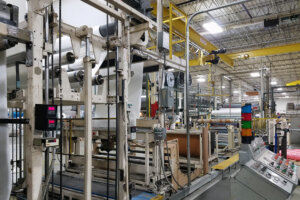Custom Adhesive Coating: The Basics

As the name implies, we modify custom adhesive coatings to fit projects perfectly. They’ll react properly to the necessary conditions, adhere to the degree that you require, and offer the appearance you need. But before you begin ordering custom adhesive coatings, let’s explore a little further into industrial coatings.
What is adhesive coating?
Keep in mind—it’s difficult to research custom adhesive coating without understanding the basics of adhesive coatings. Think of it this way: the product you’re attempting to have adhere to a surface or other product is a target. Something must wet the target in order for it to properly dry and bond to the surface or other product. When we say “wet”, though, we don’t literally mean wet, at least not in the sense of submersion or drenching. Not always, at least. Adhesive products can be liquid, or they can be solid.
What are the different types of adhesive coatings?
There are a number of different types of adhesive coatings. While you may need a custom adhesive coating for your project, that’s not always necessary. Additionally, a custom adhesive coating may be a modified version of the coatings we list below.
Some of the most notable types of coating technologies include:
Hot melt adhesives
These adhesives are the types of solid adhesives we mentioned before—they’re solid and exposed to heat in order to melt and become properly adhesive. They take less time to cure, and often they’re made of EVA, PA, olefin, polyether, and rubber. Some hot melt adhesives are “reactive”, which means they react to moisture in the air rather than heat. They’re actually heat resistant. They have low melting and coating temperatures.
Functional adhesives
We characterize these adhesives by their versatility. They come with a number of different bonding properties, which means their curing processes and adhesion speeds vary. Additionally, we can make the more durable, transparent, elastic, or conductive.
Structural adhesive
What makes structural adhesive different is its emphasis on high-strength boding. This means that they create a bond that’s both lightweight and durable. Though the adhesive can take a lot of strain and pressure, it frequently relies on “spot bonding”. This type of bonding often includes welding, bolts, and other processes that target specific places on a surface rather than broad surface spaces. Frequently, we use this process in car assembly procedures.
One-component adhesives
These adhesives cure either through heat or moisture in the air—while this may make them seem broader and more expansive, limitations exist. This is why we might choose instead to use…
Two-component adhesives
These types of adhesives have a different type of curing process entirely. You’ll mix a liquid and a hardener to create a two-component adhesive. Generally speaking, we consider these adhesives, as well as hot melt adhesives, the strongest and most durable.
How can I improve my custom adhesive coating?
Of course, we all want to utilize the strongest coating possible. That’s why custom adhesive coatings are so popular—you can improve upon existing formulas or have another one created.
Some of the most common improvements for adhesive coatings include:
- UV irradiation. We apply this improvement to plastic-based adhesives, which can be more difficult to wet due to their low surface free energy. Mold release agents often make them even more difficult to wet. UV irradiation can improve their surface free energy quickly, but we must apply a photosensitizer first.
- Flame treatment. A possible alternative to UV irradiation with similar effects is a flame treatment, which creates hydroxyl, carboxyl, and ketone groups.
- Coupling agents. Of course, we don’t only use plastic-based adhesive coatings. We also rely upon glass and silica products. In that case, you’ll want to utilize coupling agents like amino silane. When these agents react to a resin backbone containing a specific type of epoxy group, we’re able to enhance the adhesion properties of the coating much more.
Remember, it can take some trial and error to create the perfect custom adhesive coating. That’s why it’s so important to work with experts when creating such formulas, and learning as much as you can ahead of time. Likewise, partnering with a team aware of cutting-edge technology is essential.
How thick should an adhesive coating be?
We must acknowledge that there is a bit of variation in play when we work with custom adhesive coatings. The thickness of the coating can depend heavily on the project you’re working on, among other things. However, generally speaking, optimal coating thickness hovers between .05 milliliters and .14 milliliters. With that being said, the thickness of coatings can range from nanometers to centimeters.
As we’ve learned, there are a number of factors to consider as you deal with custom adhesive coatings. But good news—we’re here to help. CTI has the expertise you need to navigate this sphere. Whether you’re just beginning a project or attempting to improve the properties of an existing adhesive coating, we have you covered. Contact us here, or give us a call at 419-924-5566. Let’s find out what we can do to make adhesive coatings, custom laminates, and other products as effective as possible.
- << < Previous Post
- 1
- 2
- ...
- 35
- ...
- 240
- 241 Next Post > >>

